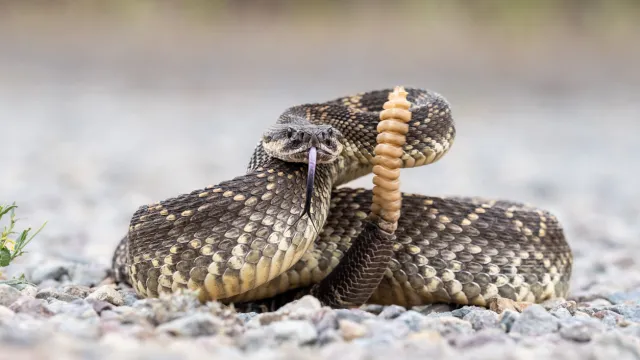First Rattlesnake Bite of the Year Prompts Urgent New Warnings

For many, the first signs of the return of warmer weather are enough reason to head out and spend time in nature. But we’re not the only ones who enjoy the unseasonably pleasant temperatures: Every time we head back out to enjoy the hiking trail or a scenic walk, we also risk encountering a venomous snake if we’re not too careful. And this week, officials have issued urgent new warnings after the first rattlesnake bite of the year was reported.
RELATED: Man Finds 3-Foot Rattlesnake in His Garage—Where It Was Hiding.
On Feb. 17, 78-year-old Martha Troy was on a hike with her daughter and granddaughter in the Spur Cross Ranch Conservation Area in Cave Creek, Arizona, to celebrate her upcoming birthday when she was suddenly surprised by a rattling sound while walking back to the trailhead, The Sacramento Bee reports. Despite the warning, Troy says there was practically no time between hearing the noise and getting bitten on the ankle by a rattlesnake.
The former intensive care unit nurse then brought herself to the hospital, where she was confirmed to be the first snakebite patient of the season in the area. And while the facility where she was treated often sees between 50 and 60 rattlesnake bites each year, they usually don’t admit their first patient until March, per a press release from the hospital.
Fortunately, Troy was able to make a full recovery after receiving treatment. But she urged others to be cautious when enjoying the outdoors, regardless of the time of year.
“Do not walk off-trail, look ahead on the ground, and back off if you hear a rattle,” Troy urged in the release. “Know what treatment you should and should not do for a rattlesnake bite, and get help immediately if you experience one.”
A representative from the hospital re-emphasized Troy’s advice to seek help in the event of a close encounter with a venomous snake.
“If you are bitten by a rattlesnake, don’t panic: The most important thing is to get to a health care facility for treatment as soon as possible,” Anne-Michelle Ruha, MD, chief of the medical toxicology department at Banner-University Medical Center Phoenix, said in the hospital’s release. “While applying a tourniquet or trying to suck out the venom are discouraged and can cause more harm, elevating the wound may aid with any swelling.”
Even though we tend to equate them with hotter weather, it’s important to stay vigilant for any snakes that may be basking in the sun while it’s still cool out, according to officials from the town of Buckeye, Arizona. Rattlesnakes tend to become more active at night during the warmer months, so it’s essential to bring a flashlight for any late hikes. Officials also caution to keep pets on a leash and to avoid placing your hands into holes, bushes, or places you can’t see.